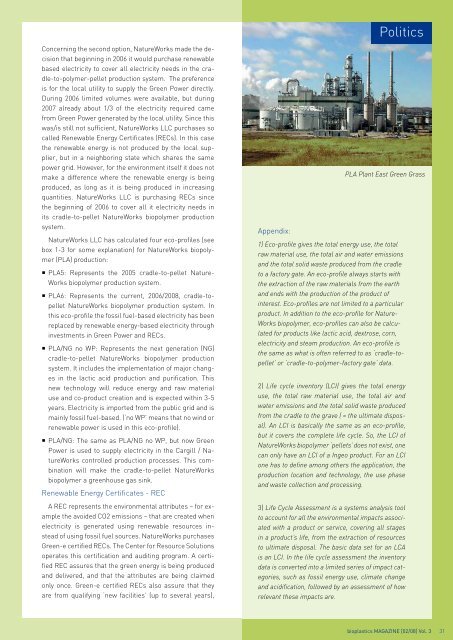02 | 2008
Create successful ePaper yourself
Turn your PDF publications into a flip-book with our unique Google optimized e-Paper software.
Concerning the second option, NatureWorks made the decision<br />
that beginning in 2006 it would purchase renewable<br />
based electricity to cover all electricity needs in the cradle-to-polymer-pellet<br />
production system. The preference<br />
is for the local utility to supply the Green Power directly.<br />
During 2006 limited volumes were available, but during<br />
2007 already about 1/3 of the electricity required came<br />
from Green Power generated by the local utility. Since this<br />
was/is still not sufficient, NatureWorks LLC purchases so<br />
called Renewable Energy Certificates (RECs). In this case<br />
the renewable energy is not produced by the local supplier,<br />
but in a neighboring state which shares the same<br />
power grid. However, for the environment itself it does not<br />
make a difference where the renewable energy is being<br />
produced, as long as it is being produced in increasing<br />
quantities. NatureWorks LLC is purchasing RECs since<br />
the beginning of 2006 to cover all it electricity needs in<br />
its cradle-to-pellet NatureWorks biopolymer production<br />
system.<br />
NatureWorks LLC has calculated four eco-profiles (see<br />
box 1-3 for some explanation) for NatureWorks biopolymer<br />
(PLA) production:<br />
• PLA5: Represents the 2005 cradle-to-pellet Nature-<br />
Works biopolymer production system.<br />
• PLA6: Represents the current, 2006/<strong>2008</strong>, cradle-topellet<br />
NatureWorks biopolymer production system. In<br />
this eco-profile the fossil fuel-based electricity has been<br />
replaced by renewable energy-based electricity through<br />
investments in Green Power and RECs.<br />
• PLA/NG no WP: Represents the next generation (NG)<br />
cradle-to-pellet NatureWorks biopolymer production<br />
system. It includes the implementation of major changes<br />
in the lactic acid production and purification. This<br />
new technology will reduce energy and raw material<br />
use and co-product creation and is expected within 3-5<br />
years. Electricity is imported from the public grid and is<br />
mainly fossil fuel-based. (‘no WP’ means that no wind or<br />
renewable power is used in this eco-profile).<br />
• PLA/NG: The same as PLA/NG no WP, but now Green<br />
Power is used to supply electricity in the Cargill / NatureWorks<br />
controlled production processes. This combination<br />
will make the cradle-to-pellet NatureWorks<br />
biopolymer a greenhouse gas sink.<br />
Renewable Energy Certificates - REC<br />
A REC represents the environmental attributes – for example<br />
the avoided CO2 emissions – that are created when<br />
electricity is generated using renewable resources instead<br />
of using fossil fuel sources. NatureWorks purchases<br />
Green-e certified RECs. The Center for Resource Solutions<br />
operates this certification and auditing program. A certified<br />
REC assures that the green energy is being produced<br />
and delivered, and that the attributes are being claimed<br />
only once. Green-e certified RECs also assure that they<br />
are from qualifying ‘new facilities’ (up to several years),<br />
Appendix:<br />
Politics<br />
PLA Plant East Green Grass<br />
1) Eco-profile gives the total energy use, the total<br />
raw material use, the total air and water emissions<br />
and the total solid waste produced from the cradle<br />
to a factory gate. An eco-profile always starts with<br />
the extraction of the raw materials from the earth<br />
and ends with the production of the product of<br />
interest. Eco-profiles are not limited to a particular<br />
product. In addition to the eco-profile for Nature-<br />
Works biopolymer, eco-profiles can also be calculated<br />
for products like lactic acid, dextrose, corn,<br />
electricity and steam production. An eco-profile is<br />
the same as what is often referred to as ‘cradle-topellet’<br />
or ‘cradle-to-polymer-factory gate’ data.<br />
2) Life cycle inventory (LCI) gives the total energy<br />
use, the total raw material use, the total air and<br />
water emissions and the total solid waste produced<br />
from the cradle to the grave ( = the ultimate disposal).<br />
An LCI is basically the same as an eco-profile,<br />
but it covers the complete life cycle. So, the LCI of<br />
NatureWorks biopolymer ‘pellets’ does not exist, one<br />
can only have an LCI of a Ingeo product. For an LCI<br />
one has to define among others the application, the<br />
production location and technology, the use phase<br />
and waste collection and processing.<br />
3) Life Cycle Assessment is a systems analysis tool<br />
to account for all the environmental impacts associated<br />
with a product or service, covering all stages<br />
in a product’s life, from the extraction of resources<br />
to ultimate disposal. The basic data set for an LCA<br />
is an LCI. In the life cycle assessment the inventory<br />
data is converted into a limited series of impact categories,<br />
such as fossil energy use, climate change<br />
and acidification, followed by an assessment of how<br />
relevant these impacts are.<br />
bioplastics MAGAZINE [<strong>02</strong>/08] Vol. 3 31


















